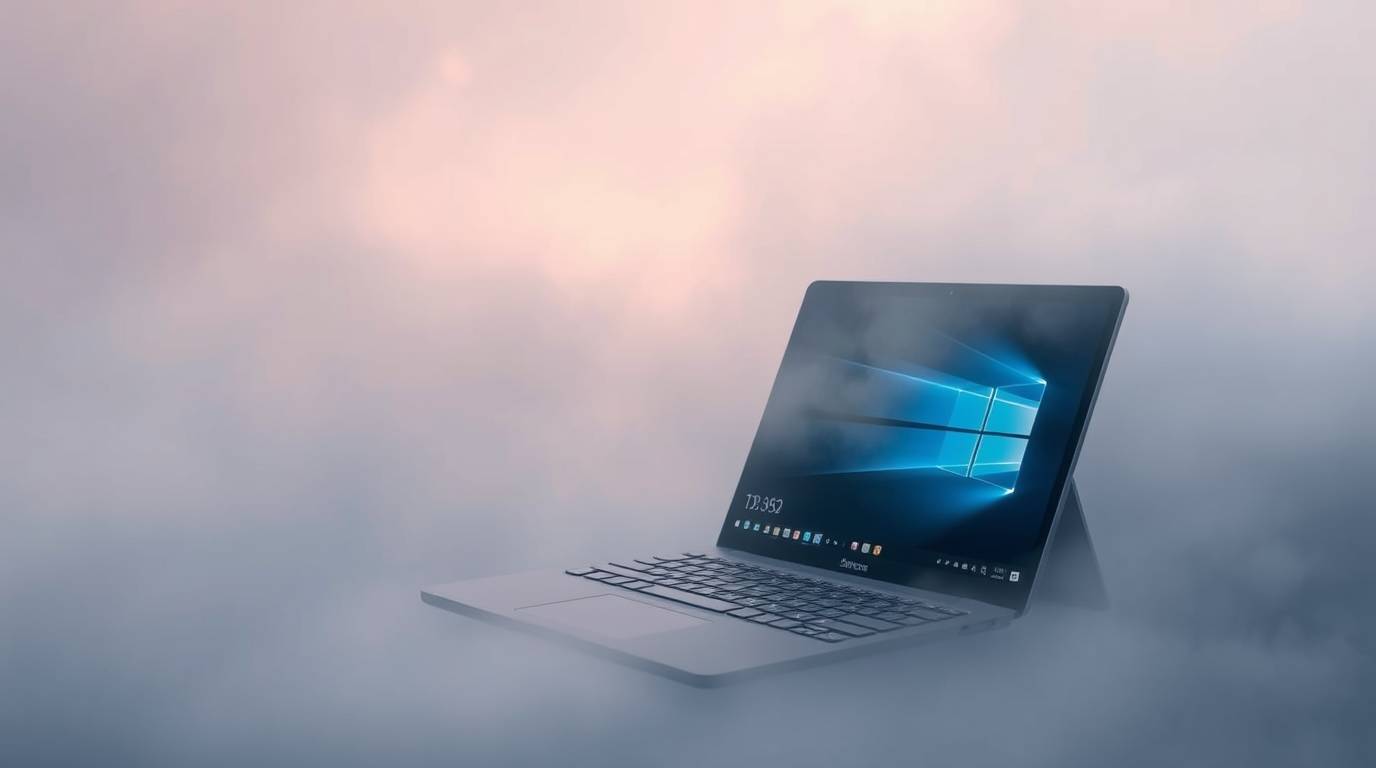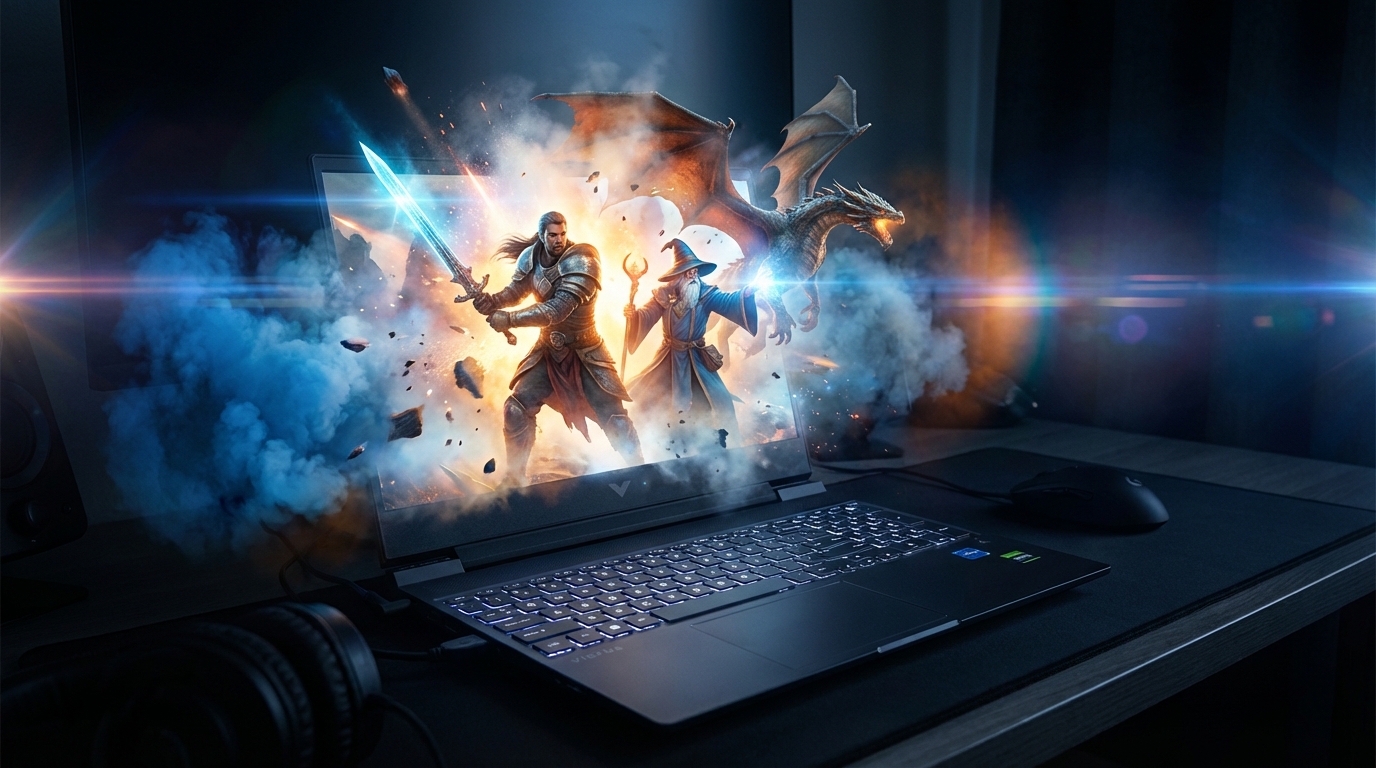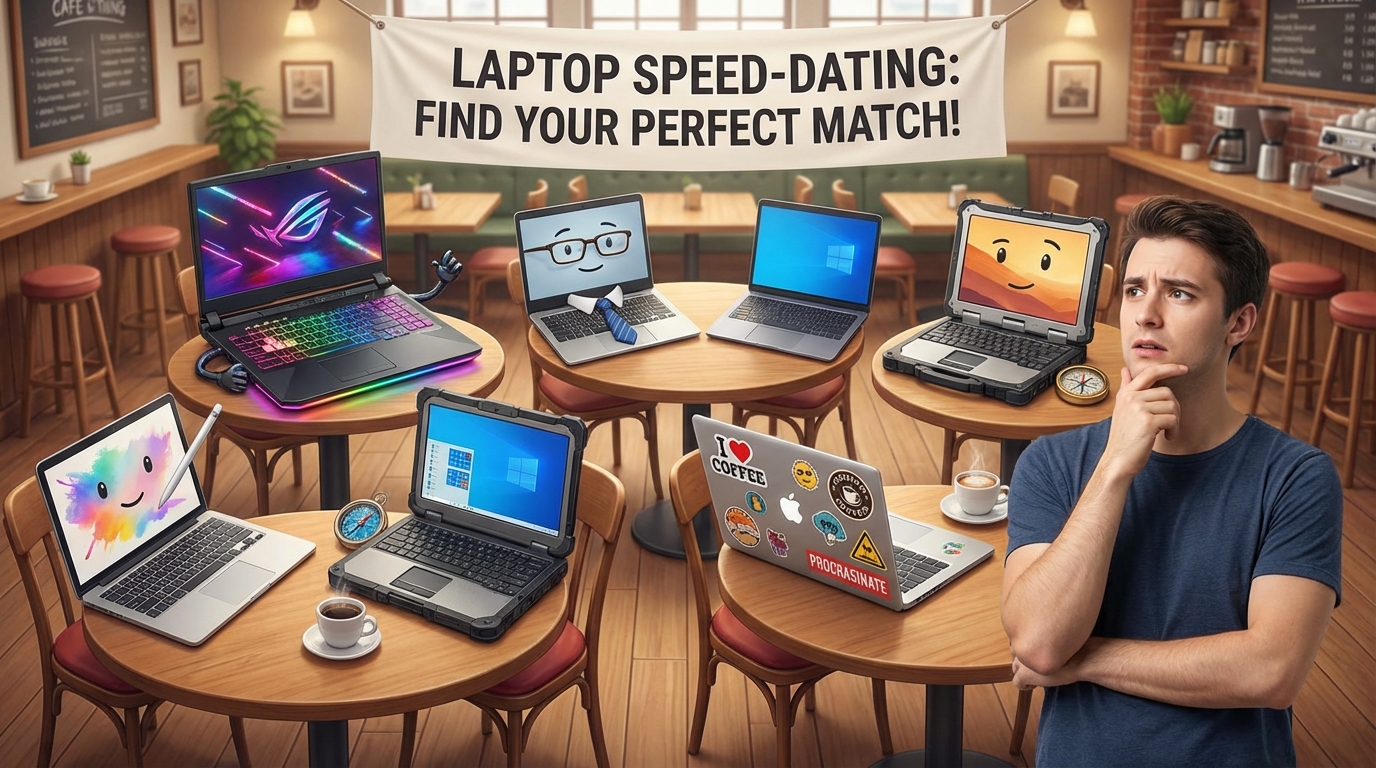The Ultimate Guide to Laptop Storage
The Ultimate Guide to Laptop Storage: Everything You Need to Know
Welcome to our comprehensive guide on laptop storage! 💻 Whether you're a tech novice or a seasoned computer user, understanding storage is essential for making smart decisions about your laptop. In this guide, we'll demystify everything about laptop storage, from the basics to advanced tips and upgrades.
Table of Contents
- The Basics of Laptop Storage
- Types of Laptop Storage: SSD vs. HDD
- How Much Storage Do You Really Need?
- Storage vs. RAM: What's More Important?
- How to Check Your Current Storage
- How to Get More Storage on Your Laptop
- Can I Upgrade My Laptop Storage?
- Where to Buy Laptop Storage & How Much to Spend
- What's the Best Kind of Laptop Storage?
- Can Laptop Storage Be Used in a Desktop?
- Storage for Specific Needs (Gaming, Video Editing, Students)
- Managing High Storage Usage
- How to Securely Wipe Your Laptop Storage
| Type | Pros | Cons | Best For |
| SSD (Solid State Drive) | Fast, silent, durable, energy-efficient | More expensive per GB, limited write cycles | Most users, especially those who value speed and durability |
| HDD (Hard Disk Drive) | More affordable, larger capacities available | Slower, vulnerable to physical damage, noisier | Budget-conscious users who need lots of storage |
| NVMe SSD | Ultra-fast speeds, compact form factor | Most expensive option, might require modern laptop | Power users, gamers, content creators |
| External Storage | Portable, no installation required | Additional item to carry, slower connection | Supplementary storage, backups, file transfer |
| Cloud Storage | Accessible anywhere, no physical space needed | Requires internet connection, ongoing costs | Collaborative work, automatic backups |
The Basics of Laptop Storage 🧠
What is Laptop Storage?
Laptop storage is the component in your computer that stores all your digital content when your device is powered off. Think of it as your laptop's long-term memory. 🧠 Unlike RAM (which temporarily holds data while you're actively using programs), storage retains everything permanently – your operating system, applications, documents, photos, videos, and all other files.
Physically, laptop storage is a hardware device installed inside your laptop that holds all this data. Modern laptops typically use one of two main storage technologies: Solid State Drives (SSDs) or Hard Disk Drives (HDDs), with SSDs becoming increasingly common.
What is Laptop Storage Used For?
Laptop storage serves several critical functions:
- Operating System Storage: Your Windows, macOS, or Linux system files live here
- Application Storage: All your installed programs and apps
- User Data Storage: Your documents, photos, videos, music, and downloads
- Virtual Memory: When RAM is full, your laptop uses storage as "overflow" memory (known as page file or swap space)
- Temporary Files: Cache, cookies, and other temporary system files
Without sufficient storage, you'd quickly run into problems installing new applications or saving files. And the type of storage you have directly impacts your laptop's performance and responsiveness!
Storage vs. Memory: People often confuse storage with memory (RAM). Here's an easy way to remember the difference: Storage is like your filing cabinet (permanent), while RAM is like your desk (temporary workspace). Both are essential but serve different purposes!
Types of Laptop Storage: SSD vs. HDD 🔄
What's the Difference Between SSD and HDD?
The two primary storage technologies found in laptops today are SSDs (Solid State Drives) and HDDs (Hard Disk Drives). They work in fundamentally different ways:
Hard Disk Drives (HDDs):
- How they work: HDDs use spinning magnetic disks (platters) and a mechanical arm with a read/write head that physically moves to access data – similar to an old-school record player 💿
- Pros: More affordable per gigabyte, available in very large capacities (up to 20TB for some desktop versions)
- Cons: Slower performance, more power-hungry, vulnerable to physical shock (dropping), produce noise and heat, heavier
- Typical speeds: 80-160 MB/s read/write speeds
Solid State Drives (SSDs):
- How they work: SSDs use flash memory chips with no moving parts – more like a super-advanced USB drive ⚡
- Pros: Much faster performance (5-20× faster than HDDs), more durable (no moving parts), lighter, silent operation, energy efficient, less heat production
- Cons: More expensive per gigabyte, lower maximum capacities (though this gap is shrinking)
- Typical speeds: 500-3500+ MB/s read/write speeds (depending on connection type)
SSD Connection Types:
There are several types of SSDs, differentiated mainly by their connection interface:
- SATA SSDs: Use the same connection as HDDs, offering speeds up to ~550 MB/s
- NVMe SSDs: Connect directly to the PCIe bus for dramatically faster speeds (up to 7000+ MB/s)
- M.2 SSDs: A form factor (physical shape/size) that can use either SATA or NVMe connections
Pro Tip: 🔍 When shopping for an SSD, pay attention to both the form factor (2.5", M.2, etc.) AND the connection type (SATA or NVMe). Many modern thin laptops only support M.2 drives, while older laptops might only support 2.5" SATA drives.
What Kind of Laptop Storage Do I Need?
For most users today, an SSD is the clear choice for your primary storage. Here's my general recommendation:
- For most users: An SSD is worth the extra cost. The performance improvement is dramatic – your laptop will boot in seconds instead of minutes, applications will launch almost instantly, and the entire system will feel much more responsive.
- For budget-conscious users with large storage needs: Consider a dual-drive setup (if your laptop supports it) with an SSD for your operating system and applications, and an HDD for large file storage.
- For power users (video editors, gamers, developers): An NVMe SSD will provide the best performance, especially when working with large files.
The difference between using an HDD and an SSD is one of the most noticeable upgrades you can make to any laptop. Many users describe it as "feeling like a brand new computer." 🚀
How Much Laptop Storage Do I Need? 📊
This is one of the most common questions, and the answer varies widely depending on your use case. Here's a breakdown to help you decide:
Storage Needs by User Type:
- Light users (web browsing, email, documents): 128-256GB SSD
- Average users (some photos, music, videos): 512GB SSD
- Heavy users (large media collections, games): 1TB SSD or more
- Professional users (video editing, 3D rendering): 1-2TB SSD or more
Is Higher Storage Always Better?
Not necessarily! While having more storage gives you more flexibility, there are several factors to consider:
- Cost considerations: Storage cost increases with capacity. Spending extra on storage might mean compromising on other important specs like processor, RAM, or display quality.
- External alternatives: With cloud storage and external drives being affordable options, you might not need massive internal storage.
- Speed vs. capacity: Often, you'll face a choice between a smaller, faster SSD or a larger, slower HDD. For most users, the speed advantage of an SSD outweighs having more space with an HDD.
🧮 Storage Capacity Reality Check: When considering storage capacity, remember that the operating system takes up space! Windows 11 requires about 64GB, macOS about 35GB. Also, advertised capacities are slightly less in practice due to how storage is calculated (a "500GB" drive provides about 465GB of actual space).
Remember: You can always add external storage later, but you can't always upgrade internal storage easily. When in doubt, get a bit more than you think you need, especially if you plan to keep the laptop for several years.
Storage vs. RAM: What's More Important? 🤔
Both storage and RAM are crucial components, but they serve very different purposes:
- RAM (Random Access Memory): Temporary, high-speed memory that holds active programs and data you're currently using. More RAM allows you to run more applications simultaneously without slowdowns.
- Storage: Permanent memory that holds all your files even when the computer is off. More storage allows you to keep more files and install more applications.
Which Should You Prioritize?
This depends on your specific needs:
- Prioritize RAM if: You multitask heavily, run virtual machines, use memory-intensive applications like video editors or 3D modeling software, or keep many browser tabs open simultaneously.
- Prioritize storage if: You work with large files (video, high-res photos), have a large media collection, install many games or applications, or need to keep lots of files locally.
For a balanced approach, I recommend these minimum specifications for a modern laptop:
- At least 8GB RAM (16GB preferred for future-proofing)
- At least 256GB SSD storage (512GB preferred)
💡 Pro Tip: If forced to choose between more RAM or more storage with a limited budget, I'd generally recommend prioritizing RAM up to 16GB, then focusing on getting at least 512GB of SSD storage. You can always add external storage, but upgrading RAM is often more difficult or impossible on modern laptops.
How to Check Your Current Laptop Storage 🔍
Before considering upgrades or purchases, it's helpful to understand what you currently have and how you're using it.
Checking Storage on Windows:
- Quick view: Click the Start button, then type "This PC" and open it. Your drives will be listed with their total capacity and free space.
- Detailed view: Right-click on Start button → Select "Disk Management" to see all drives, their types, and partitions.
- Storage usage breakdown: Go to Settings → System → Storage to see what's taking up space on your drive.
Checking Storage on macOS:
- Quick view: Click the Apple menu → About This Mac → Storage tab.
- Detailed view: Click the Apple menu → About This Mac → Storage → Manage to see storage usage by category.
- Technical details: Apple menu → About This Mac → System Report → Storage to see drive type and connection.
Checking Drive Type (SSD vs. HDD):
On Windows:
- Open Command Prompt or PowerShell
- Type
wmic diskdrive get model,name,sizeand press Enter - Look for terms like "SSD" or "SATA" in the model names
On macOS:
- Click the Apple menu → About This Mac → System Report → Hardware → SATA/SATA Express
- Check the "Physical Interconnect" field which will show "SATA", "PCI", or "NVMe"
⚠️ Warning: If you're frequently running out of storage space, your laptop's performance will suffer! Windows and macOS both need some free space to operate efficiently. Aim to keep at least 15-20% of your drive free.
How to Get More Storage on Your Laptop 📈
Running out of space? There are several approaches to expanding your storage capacity:
1. Clean Up Existing Storage
Before spending money on new hardware, try these free space-saving techniques:
- Use built-in cleaning tools:
- Windows: Storage Sense (Settings → System → Storage)
- macOS: Storage Management (Apple menu → About This Mac → Storage → Manage)
- Uninstall unused applications
- Use cleanup software like CCleaner to remove temporary files
- Move files to cloud storage services like Google Drive, OneDrive, or Dropbox
- Use Windows Storage Analyzer or macOS Storage Management to identify large files
2. Use External Storage Solutions
- External hard drives: Affordable option for large backups (1-5TB common)
- External SSDs: Faster but more expensive option, great for actively used files
- USB flash drives: Portable solution for small to medium-sized file transfers
- SD cards: If your laptop has an SD card slot, this can be a semi-permanent storage extension
- Network Attached Storage (NAS): For home network file sharing and backups
3. Cloud Storage Services
Cloud storage is increasingly popular and offers several advantages:
- Access from anywhere with internet connection
- Automatic backup protection against hardware failure
- File sharing and collaboration capabilities
- Popular options: Google Drive, Microsoft OneDrive, Dropbox, iCloud, Amazon Drive
4. Internal Storage Upgrade
The most permanent solution is upgrading your internal storage (covered in detail in the next section).
🎯 Strategy Tip: For many users, a hybrid approach works best: SSD internal storage for your OS and frequently used applications, external HDD for large media libraries and backups, and cloud storage for important documents and collaborative work.
Can I Upgrade My Laptop Storage? 🔧
The answer is: it depends on your laptop model. Many laptops allow for storage upgrades, but some ultra-thin models have storage soldered directly to the motherboard, making upgrades impossible.
How To Determine If Your Laptop Storage Is Upgradeable
- Check the manufacturer's website for your specific laptop model
- Look up your laptop model on repair sites like iFixit or YouTube tutorials
- Consult your laptop's service manual (often available on the manufacturer's website)
- Look for access panels on the bottom of your laptop (signs of upgradeable components)
How Do I Upgrade My Laptop Storage?
If your laptop supports storage upgrades, here's the general process:
For HDD to SSD Upgrade (2.5" drives):
- Backup your data to an external drive or cloud storage
- Purchase a compatible SSD of the desired capacity
- Create a bootable clone using software like Macrium Reflect (Windows) or Carbon Copy Cloner (Mac)
- Power down completely and unplug the laptop
- Remove the back panel or access door (refer to your laptop manual)
- Locate the drive bay and carefully disconnect the existing drive
- Install the new SSD in the same location
- Reassemble your laptop and boot it up
For M.2 SSD Installation/Upgrade:
- Verify compatibility (SATA M.2 vs. NVMe M.2)
- Back up your data
- Power down completely and unplug
- Access the M.2 slot (often requires removing the entire bottom panel)
- If replacing an existing M.2 drive, remove the small retention screw and carefully remove the old drive
- Insert the new M.2 SSD at a 30-degree angle, then press down and secure with the retention screw
- Reassemble and restore your data
⚠️ Important: Upgrading internal components may void your warranty! If you're not comfortable with this process, consider having it done professionally. Always ground yourself to prevent static electricity damage to components.
For visual learners, there are excellent video tutorials available on YouTube for most popular laptop models.
Where to Buy Laptop Storage & How Much to Spend 💰
Where Can I Buy Laptop Storage?
There are several reliable places to purchase laptop storage:
- Online retailers: Amazon, Newegg, B&H Photo
- Computer stores: Best Buy, Micro Center
- Direct from manufacturers: Samsung, Crucial, Western Digital, etc.
- Refurbished options: Some vendors offer certified refurbished drives at lower prices
How Much Should I Spend on Storage?
Storage pricing varies based on type, capacity, and performance. Here's a general pricing guide:
- 2.5" SATA SSDs: $40-60 for 250GB, $60-80 for 500GB, $90-120 for 1TB
- NVMe M.2 SSDs: $50-80 for 250GB, $80-120 for 500GB, $110-180 for 1TB
- 2.5" HDDs: $30-40 for 500GB, $40-60 for 1TB, $60-80 for 2TB
- External SSDs: $70-100 for 500GB, $120-180 for 1TB
- External HDDs: $50-60 for 1TB, $60-80 for 2TB, $100-130 for 4TB
💸 Budget Tip: Watch for sales around major shopping events like Black Friday, Cyber Monday, and Prime Day. Storage devices often see significant discounts during these periods!
What to Look For When Buying Laptop Storage
- Compatibility: Make sure the form factor and interface match your laptop's specifications
- Capacity: Balance your needs with your budget
- Performance: Check read/write speeds, especially for SSDs
- Reliability: Look at warranty periods and TBW (Terabytes Written) ratings for SSDs
- Brand reputation: Stick with established manufacturers known for reliability
For most users, I recommend spending a bit more for a reliable brand with good warranty support, rather than choosing the absolute cheapest option.
What's the Best Kind of Laptop Storage? 🏆
Does Faster Storage Improve Performance?
Absolutely! Storage speed has a significant impact on:
- Boot times: How quickly your laptop starts up
- Application launch speed: How fast your programs open
- File transfer rates: How quickly you can copy, move, or save large files
- Game loading times: How long you wait for game levels to load
- System responsiveness: The overall "snappiness" of your laptop
The performance difference is most noticeable when upgrading from an HDD to any SSD. The difference between types of SSDs (SATA vs. NVMe) is less dramatic for everyday tasks but becomes more apparent when working with very large files.
What's the Best Brand for Laptop Storage?
Several manufacturers consistently produce reliable storage products:
For SSDs:
- Samsung: Consistently high performance, excellent reliability, good software (Samsung Magician)
- Western Digital: Reliable with good performance across price ranges
- Crucial: Excellent value, owned by Micron (a major memory manufacturer)
- SK Hynix: Growing reputation for reliable, high-performance drives
- SanDisk: Good performance, now owned by Western Digital
For HDDs:
- Seagate: Wide range of reliable options
- Western Digital: Reliable with clear product lines
- Toshiba: Good reliability and value
🔍 My Recommendations: For most users, I recommend Samsung 870 EVO for SATA SSDs and Samsung 970 EVO Plus or WD Black SN750 for NVMe drives. These offer an excellent balance of performance, reliability, and value. If you're more budget-conscious, Crucial MX500 (SATA) and Crucial P2 (NVMe) are great alternatives.
Can Laptop Storage Be Used in a Desktop? 🖥️
Yes, laptop storage drives can typically be used in desktop computers, but there are some considerations:
Using Laptop HDDs in Desktops
- Physical size: Laptop HDDs are 2.5" while desktop HDDs are typically 3.5"
- Mounting: You'll need an adapter bracket to mount a 2.5" drive in a 3.5" bay
- Connection: Both use standard SATA connections, so compatibility is good
- Performance: Laptop HDDs (5400 RPM typically) are usually slower than desktop HDDs (7200 RPM)
Using Laptop SSDs in Desktops
- 2.5" SATA SSDs: Directly compatible with desktop SATA ports (may need mounting bracket)
- M.2 SSDs: Require a desktop motherboard with M.2 slots or a PCIe adapter card
- Connection type matching: Ensure SATA M.2 drives go to SATA M.2 slots, and NVMe drives to PCIe M.2 slots
In fact, there's often no distinction between "laptop" and "desktop" SSDs – many models are marketed for both uses.
📋 Upgrade Tip: When upgrading your laptop storage, consider keeping the old drive and purchasing an external enclosure to convert it into a portable external drive! This is an excellent way to get more value from your old hardware.
Storage for Specific Needs 🎮📹🎓
What Kind of Laptop Storage Do I Need for Gaming?
Gamers have unique storage requirements due to the large size of modern games and the impact loading times have on gaming experience:
- Capacity needs: Modern AAA games can range from 50GB to over 100GB each! For a decent gaming library, aim for at least 1TB of storage.
- Speed requirements: An NVMe SSD will provide the fastest load times. Games benefit significantly from faster storage.
- Hybrid approach: Many gamers use a fast SSD for the operating system and current games, with a larger HDD for less frequently played titles or media storage.
For serious gamers, I recommend a 512GB-1TB NVMe SSD at minimum, with additional storage (either internal or external) for your growing game library. Consider drives specifically marketed for gaming, like the WD Black series or Samsung 980 Pro, which optimize for the sustained read performance that benefits games. 🎮
🎮 Gaming Tip: Many game platforms like Steam allow you to install games on different drives and easily move them between drives. Keep your current rotation of games on your fastest SSD, and store less-played titles on a secondary drive.
What Kind of Laptop Storage Do I Need for Video Editing?
Video editing is one of the most storage-intensive tasks you can perform on a laptop. Here's what you need:
- Capacity: Video files are enormous—aim for at least 1TB, preferably 2TB or more
- Speed: NVMe SSD is strongly recommended for scrubbing through footage and rendering
- Multiple drives setup: For serious video editing, consider a workflow with:
- Fast NVMe SSD for OS and applications
- Separate SSD for active project files
- Large external drives for archiving completed projects
- External solutions: External SSDs with Thunderbolt or USB 3.2 connections provide excellent expansion options for video editors
For video editing, don't skimp on storage performance—the time savings during rendering and the smoother timeline scrubbing experience are worth the investment in faster storage. 🎬
What Kind of Laptop Storage Do I Need as a Student?
Students typically have more modest storage needs, but still benefit from reliable, fast storage:
- Capacity: 512GB is usually sufficient for most students (documents, presentations, research papers don't take much space)
- Type: An SSD is highly recommended for reliability and speed
- Special considerations:
- Art/Design students: May need 1TB+ for large creative files
- Computer Science/Engineering: Development environments and virtual machines can be space-intensive
- Film/Media students: Similar needs to video editors (see above)
For most students, I'd recommend a 512GB SSD for a good balance of space and affordability. Supplement with cloud storage (many universities offer free or discounted cloud storage) for backups and collaboration. 🎓
💼 Student Tip: Many educational institutions provide significant cloud storage through Google Workspace or Microsoft 365 Education accounts. Take advantage of these resources to keep local storage needs manageable!
Why Is My Laptop Using So Much Storage? 📉
If your storage is filling up mysteriously, several culprits could be responsible:
Common Storage Space Consumers:
- System Restore Points and Backups: Windows can store multiple restore points that consume significant space
- Temporary Files: Browser caches, application temp files, and Windows temp files accumulate over time
- Downloads Folder: Often becomes a catch-all for forgotten large files
- Application Cache: Apps like Spotify, Adobe applications, and browsers can store gigabytes of cached data
- Duplicate Files: Multiple copies of photos, documents, or downloads
- Windows Component Store (WinSxS folder): Can grow very large over time
- Hibernation File: Can be sized equal to your RAM
- Old Windows Updates: Previous update packages remain on your system
How to Identify Storage Space Hogs:
On Windows:
- Use the built-in Storage Settings (Settings → System → Storage)
- Try third-party tools like WinDirStat, TreeSize Free, or SpaceSniffer to visualize storage usage
- Use Disk Cleanup (including system files) to remove temporary files
On macOS:
- Use Storage Management (Apple menu → About This Mac → Storage → Manage)
- Try third-party apps like DaisyDisk or OmniDiskSweeper
- Check for "Other" storage which often includes system caches and logs
Tips to Free Up Space:
- Uninstall unused applications
- Clear browser caches regularly
- Use streaming services instead of downloading media
- Enable Storage Sense in Windows to automatically clean temporary files
- Move photos and videos to cloud storage
- Delete old downloads you no longer need
- Use external drives for large media collections
⚠️ Warning: Be careful when deleting files from system folders or using cleanup utilities that promise to "optimize" your system. Stick to built-in tools or reputable third-party applications to avoid accidentally removing essential files.
How Do I Securely Wipe My Laptop Storage Before Selling It? 🔒
When selling or donating your laptop, it's crucial to properly erase your data to protect your privacy. Simply deleting files or even formatting doesn't truly remove your data!
For Windows Laptops:
- Back up important data to an external drive or cloud storage
- Sign out of all accounts and deactivate software licenses
- Use Windows built-in reset feature:
- Go to Settings → Update & Security → Recovery
- Under "Reset this PC," click "Get started"
- Choose "Remove everything"
- Select "Change settings" and enable "Data erasure" (this takes longer but is more secure)
- Follow the prompts to complete the process
- For maximum security: Consider using third-party tools like DBAN (Darik's Boot and Nuke) for HDDs or manufacturer-specific secure erase tools for SSDs
For macOS Laptops:
- Sign out of iCloud, iMessage, and other Apple services
- For Intel-based Macs:
- Restart in Recovery Mode (Command + R during startup)
- Select Disk Utility
- Select your drive and click "Erase"
- Choose "Mac OS Extended (Journaled)" format
- Enable "Security Options" and select the secure erase level
- After erasing, quit Disk Utility
- Choose "Reinstall macOS" from the Recovery menu
- For Apple Silicon Macs:
- Go to System Preferences → Erase All Content and Settings
- Follow the prompts to complete the process
🔐 Security Tip: SSDs handle data erasure differently than HDDs. For SSDs, use the manufacturer's secure erase tool when possible, as it addresses SSD-specific challenges like wear leveling. Samsung, Intel, and Crucial all offer secure erase utilities for their SSDs.
Special Considerations for Different Storage Types
- HDDs: Multiple pass overwriting is most secure
- SSDs: Secure Erase command or encryption-based wiping is preferred (due to how SSDs write data)
- Hybrid Drives: Treat as an SSD for wiping purposes
Remember that a secure wipe takes significantly longer than a quick format, but the privacy protection is worth the wait. For especially sensitive data, physical destruction of the drive is the only 100% secure method.
Conclusion: Making Smart Storage Decisions 🧠
Your laptop's storage is one of its most critical components—it affects everything from performance to capacity to reliability. Here are the key takeaways from this guide:
- SSD vs. HDD: In most cases, an SSD is worth the investment for significantly better performance
- Capacity planning: Balance your needs with your budget, and remember that external options can supplement internal storage
- Performance matters: Faster storage improves your entire computing experience
- Upgrades are possible: Many laptops allow storage upgrades, which can extend the useful life of your device
- Security considerations: Properly wipe storage before selling or disposing of a laptop
When making storage decisions, consider both your current and future needs. Storage requirements tend to grow over time as software becomes more complex and file sizes increase.
Whether you're a student, gamer, creative professional, or casual user, I hope this guide has helped you understand laptop storage better and make more informed decisions about your next laptop purchase or upgrade! 💻✨
Have More Questions About Laptop Storage?
Feel free to leave a comment below with any specific questions about your laptop storage needs, and I'll do my best to help! And if you found this guide useful, please share it with friends or colleagues who might also benefit.




